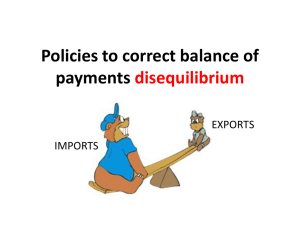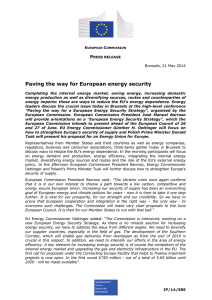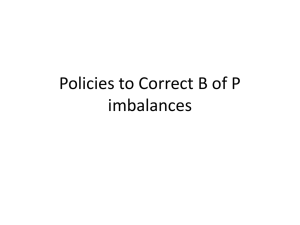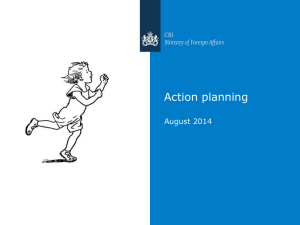EU gas imports in 2012 (2)
advertisement
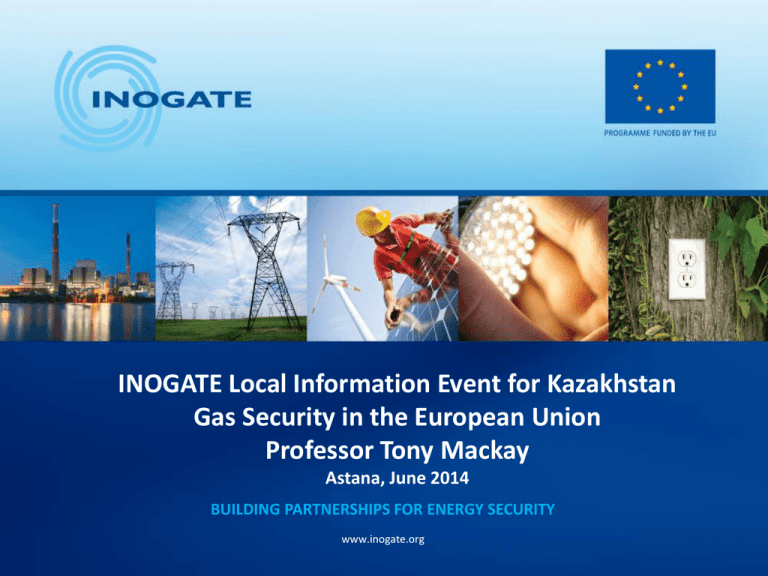
INOGATE Local Information Event for Kazakhstan Gas Security in the European Union Professor Tony Mackay Astana, June 2014 BUILDING PARTNERSHIPS FOR ENERGY SECURITY www.inogate.org EU energy overview (1) • EU accounts for about 13% of world primary energy consumption • China accounts for about 22% and USA 18% • EU energy consumption has been falling since 2006, mainly because of energy efficiency and conservation policies • Also, because of financial and economic crises 2008-10 • I expect EU energy consumption to continue to decline in the future EU energy overview (2) • 27 member states ranging from • Rich, developed countries such as Germany, UK and France, to • Poorer, developing countries such as Bulgaria, Poland and Romania • New members such as Croatia • Energy trends in individual countries can be very different EU primary energy consumption in 2012 % breakdown EU primary energy consumption in 2012 6% 4% 12% 37% oil gas coal nuclear hydro 18% renewables 24% EU primary energy and gas consumption, 2002-2012 million tonnes oil equivalent, mtoe 2500.0 2300.0 2100.0 1900.0 1700.0 1500.0 1300.0 1100.0 900.0 700.0 500.0 2002 2003 2004 2005 2006 Energy 2007 2008 Gas 2009 2010 2011 2012 EU primary energy consumption in 2012 (million tonnes oil equivalent, mtoe) mtoe % oil 611.3 36.5 gas 399.5 23.9 coal 293.7 17.6 nuclear 199.8 11.9 hydro 74.0 4.4 renewables 95.0 5.7 Total 1673.4 EU gas overview (1) • Gas accounted for 24% of total primary energy consumption in 2012 • Share rose to 26% in 2010 but has fallen since then • Main reason for that has been high gas prices relative to other fuels notably coal prices • Also, substantial growth in wind energy production which is heavily subsidised EU gas overview (2) • EU gas consumption 443.9 billion cubic metres (bcm) in 2012 • EU gas production 149.6 bcm in 2012 • Production was 34% of consumption in 2012, compared with 50% in 2002 • Gas imports accounted for 66% of consumption in 2012 • Netherlands accounted for 43% of EU gas production in 2012 and UK 27% • Smaller gas production in other countries such as Denmark, Germany, Italy and Romania • UK gas production (from the North Sea) has fallen by more than half since 2002, which is the main reason for the rise in EU gas imports • I expect EU gas production to continue to decline • I therefore expect EU gas imports to continue to increase EU gas as % of total energy consumption 26.5 26.0 25.5 25.0 24.5 24.0 23.5 23.0 22.5 22.0 2002 2003 2004 2005 2006 2007 Gas 2008 2009 2010 2011 2012 EU gas imports in 2012 (1) • Gas pipeline imports accounted for 78% of the total • LNG imports 22% but that proportion has been increasing • Sources of pipeline imports were Norway (33% of total), Russian Federation (33%), Algeria (10%) and Libya (2%) • Imports from Russian Federation include transit imports from other countries such as Kazakhstan and Turkmenistan. • Main sources of LNG imports were Qatar (10%), Algeria (4%) and Nigeria (4%) EU gas imports in 2012 (2) By pipeline Norway Russian Federation Algeria Libya Sub-total Liquified Natural gas (LNG) Qatar Algeria Nigeria Other Countries Sub-total Total billion cubic meters 106.6 105.5 32.8 6.5 251.4 31.1 14.4 11.6 12.7 69.8 321.2 % 33.2 32.8 10.2 2.0 9.7 4.4 3.6 4.0 EU gas imports in 2012 (3) EU gas imports in 2012 3% 4% 10% 2% 33% Norway Russian Federation Algeria Libya 15% Qatar Nigeria Other Countries 33% Gas reserves and production ratios (1) • World proven gas reserves estimated at 187.3 trillion cubic metres (tcm) • World reserves: production ratio (R:P) estimated at 55.7 • In other words the proven gas reserves would last for another 55 years at the current level of production • EU R:P ratio is only 11.7 • Kazakhstan R:P ratio is 65.6 • Middle East R:P ratio is 100+ Gas reserves and production ratios (2) trillion cubic meters R:P ratio 187.3 55.7 EU total 1.7 11.7 Middle East total 80.5 100+ Norway 2.1 18.2 Netherlands 1.0 16.3 UK 0.2 6.0 Kazakhstan 1.3 65.6 Russia Federation 32.9 55.6 Turkmenistan 17.5 100+ Qatar 25.1 100+ Iran 33.6 100+ World total Major gas trade movements Norway gas • • • • • • • • • • 2012 production was 114.9 billion cubic metres (bcm) 2012 consumption was just 4.3 bcm 96% of Norwegian gas production was exported Most of Norway’s electricity production is from hydro power so there is little need to consume gas domestically Of the exports 95% were by pipeline and 5% LNG Most of the pipeline exports went to Germany, UK and France LNG exports went to a wide range of countries, including Japan, USA and Argentina Norway’s gas: reserves ratio (R:P) is estimated at 18.2 In other words, Norway could produce gas for about another 18 years at the current level of production However, much of the Norwegian Continental Shelf remains unexplored so it is likely/possible that more gas reserves will be discovered Future EU gas supplies (1) • EU gas consumption is forecast to continue to decline • However, EU gas production is forecast to decline at a greater rate • Therefore EU gas imports are expected to increase in the future • Current gas imports are about 78% by pipeline and 22% LNG • Most of the pipeline imports are from Norway (33% of total), Russian Federation (33%) and Algeria (10%) • LNG exports have been increasing and come from various countries, including Qatar (10%), Algeria (4%) and Nigeria (4%) Future EU gas supplies (2) • No reason to expect any significant change in imports from Norway • Imports from Russian Federation less certain because of the recent problems in Ukraine • Likely to be continuing growth in LNG imports from Qatar and other countries • Possibility also of imports of shale gas LNG from USA • Relative gas prices will be very important: Norway v Russian Federation v LNG v shale gas Future EU gas supplies (3) • Russian Federation diversifying away from Ukraine transit, notably Nord Stream and South Stream pipelines • Plans for other gas import pipelines, notably Azerbaijan-Turkey-EU • Trans-Caspian gas pipeline would increase export opportunities for Kazakhstan and Turkmenistan • Substantial potential for gas imports from Iran via Turkey • Plans for more LNG import terminals in the EU, which will increase competition with pipeline imports from RF, Norway and elsewhere

